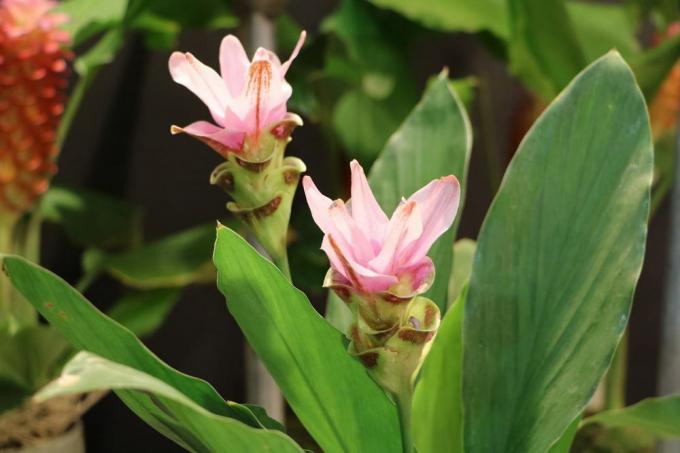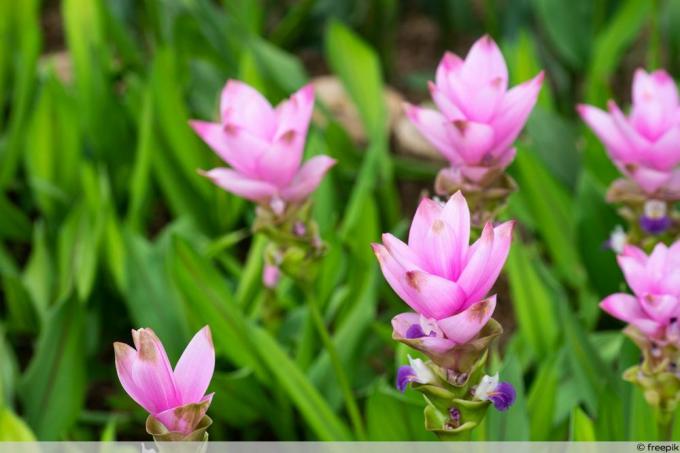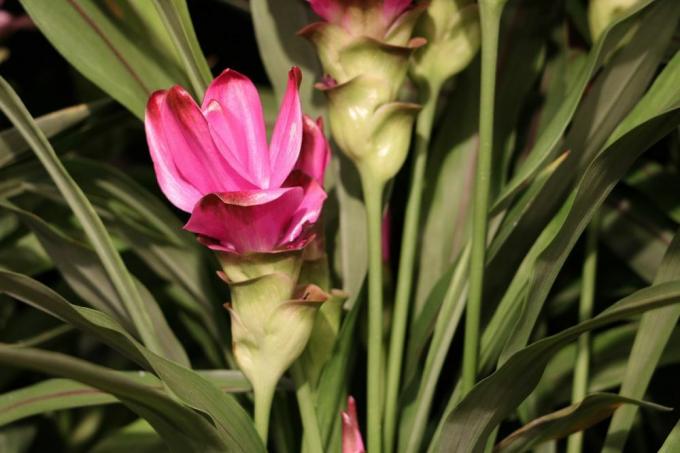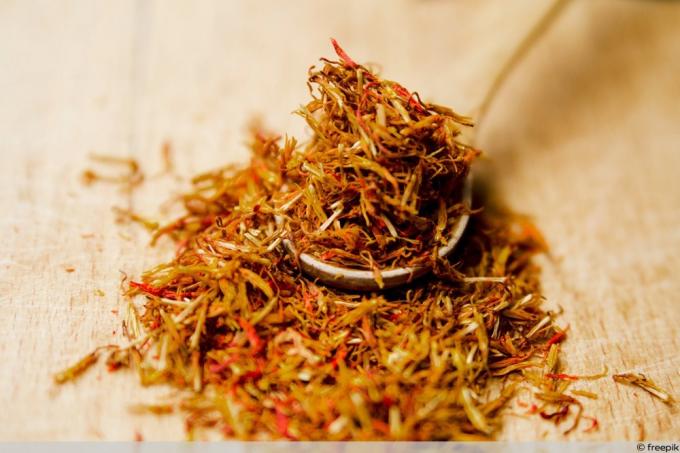
table of contents
- Characteristics
- Location
- Water and fertilize
- Cutting and wintering
- Moisture requirement
- Plants and Propagation
- Food and medicine
- Diseases and pests
Profile and care information open +conclude -
- Flower color
- multicolored, pink, violet, white
- Location
- Partial shade, shady, sunny
- Heyday
- April May June
- Growth habit
- upright, expansive
- height
- up to 80 cm high
- Soil moisture
- moderately moist
- PH value
- neutral, weakly alkaline
- Limescale tolerance
- k. A.
- humus
- rich in humus
- Poisonous
- no
- Plant families
- Ginger family, Zingiberaceae
- Plant species
- Aromatic plants, ornamental plants, container plants, bedding plants, potted plants, house plants
- Garden style
- Flower garden, ornamental garden, pot garden
Saffron root comes from the ginger family. Its home is in Australia and Asia, but in this country it can also be cultivated as a houseplant or garden plant. It is a bulbous plant that not only grows in height but also in width.
Curcuma alismatifolia - as the botanical name is - is not evergreen, it begins to lose its leaves at the latest at the beginning of winter. The complete leaves are gradually thrown off and at the latest then it is time for wintering.
In spring, the first flower stems form again, the flower color varies from purple to pink to white. Curcuma is very popular among hobby gardeners, especially because of its large, lush green leaves and beautiful flowers.
Characteristics
- Countries of origin are South Asia and Australia
- Turmeric is grown in beds or pots
- Flowering time is in spring
- the stature height is 80 cm
- the saffron root is not winter hardy
- undemanding in care, has to be repotted annually
- herbaceous, perennial
- belongs to the ginger family
Location
Since the saffron root can expand enormously in width, it is the ideal specimen plant. But it can also find its location in the mixed herbaceous bed. A combination of flowering plants and turmeric is visually very appealing, as a colorful carpet of flowers can then develop.
In terms of its place, turmeric does not have enormous claims. Turmeric appreciates places that are flooded with light, but should not be exposed to the blazing sun. A location in partial shade is ideal, with potted plants with the option of finding a place in the shade.
The right location in the overview
- a loose, humus-rich substrate is suitable
- the saffron root prefers light soil
- Soil should be slightly moist, normally rich in nutrients and permeable to water
- loosen dense soils
- Loamy soils should be enriched with compost
- drainage with pebbles makes sense
- Place should be protected from the sun but bright
- Morning and evening sun are well tolerated
- Midday heat and strong sun cause burns
- dry soil and drafts are to be avoided
- Turmeric is a good houseplant
- The bucket must be big and wide enough
- It is easier to overwinter with potted plants
Water and fertilize

As an easy-care plant, you don't have to take much care of turmeric. However, it is necessary that you provide an optimal environment for the turmeric plant so that it can grow and thrive. Long periods of drought are to be avoided in particular, as the plant does not appreciate this at all. In addition, it has to be fertilized occasionally, the dose depends on the nutrient content of the soil.
Care tips at a glance:
- Water demand increases during the flowering period
- Leaves must not come into contact with irrigation water
- is poured when the top layer of the soil has dried
- regularly water in a normal amount
- Soil should be kept moist, but not wet
- reduce watering at the end of the flowering period
- work a layer of mulch into the soil to hold in moisture
- In hot weather you have to water more
- avoid total drying out of the soil
- Both ball dryness and waterlogging are not tolerated
- Fertilization takes place depending on the soil quality
- use liquid fertilizer once a month
- Fertilization takes place between April and September, not in winter
- Fertilizer sticks are well suited for potted plants
Turmeric is undemanding and the work is not very laborious. It is important, however, that you pay attention to the right amount of irrigation water. Both absolute dryness and waterlogging are not tolerated by the plants at all. Also make sure that the amount of water required increases enormously in hot phases. It may then be possible that you have to pay attention to the moisture of the substrate more than once a day.
Cutting and wintering
It is not necessary to prune the saffron root between April and September. However, pruning makes sense in late autumn or at the beginning of winter. Here, all leaves that are not shed by themselves are cut down to the tuber. If you use scissors in autumn or winter, remove the withered leaves in close proximity to the tuber.

As a deciduous, not hardy plant, the plant tubers have to be overwintered in winter quarters. In spring, if the winter is well designed, they will sprout again.
Step by step
- Prepare the winter quarters for the plants to move in in November.
- Carefully dig up the existing rhizomes from the soil.
- Store the tubers in a frost-free, slightly warm location.
- Make sure that the room temperature does not exceed 16 degrees.
- Ensure complete dryness in the storage area.
- Bring potted plants to a frost-free, unheated room.
- With potted plants, you can leave the tuber in the tub.
- No light is necessary, complete darkness can be tolerated without any problems.
The best time to move is early to mid-November at the latest. Because when the first frost comes, it can already be too late. The existing rhizomes must be lifted out of the earth with extreme care. Do not forget that the saffron arum grows not only in height, but also in width.
A dry room that must not be warmer than 16 degrees is required as a storage space. Too much heat prevents the resting phase and the turmeric plant would not sprout again in the coming spring. It is also important to be completely dry, otherwise there is a risk of mold growth.
If you want to overwinter a potted plant, it is sufficient if you move the container into the space provided. The tubers do not have to be dug up, they can remain in their usual place.
Moisture requirement

The turmeric plant is a graceful, colorful plant that looks good on every balcony and in every garden. Only if they are properly stored in winter will they sprout again in spring.
If wintering is not carried out carefully enough, a new inflorescence cannot appear and the turmeric plant will not bloom. The first shoots usually show when the temperatures crack the 20-degree mark. However, if moisture or moisture gets into the interior of the flowers, they die.
With this type of plant, it is important to ensure that there is adequate humidity in the area. This is especially true if the Curcuma alismatifolia is in a sunny place. It is also very helpful to place a bowl of water next to the plants.
additional Information
- Bud emerges at the beginning of spring at around 22 degrees
- the flower color is purple, white or pink
- Protect flowers from direct exposure to water
- Flowering time is in spring, after which less water should be given
- no watering necessary in winter quarters
- Depending on the intensity of care, the stature is between 50 and 80 cm.
Plants and Propagation
The saffron root can be propagated independently by the hobby gardener. For this purpose, the plant is exposed in spring, alternatively the root is divided. The turmeric tuber is available in Asian supermarkets. These can be planted in spring. Existing turmeric plants are also suitable for propagation if the rhizomes are divided.
Plant correctly
- Propagation takes place by dividing the rhizomes
- The right time is when budding begins
- Repotting the tubers once a year
- the plant is planted out in spring
- Preparations for transplanting should take place at the end of February
- at this time the tuber is moved to a bright place
- Water moderately again from March
Food and medicine

The saffron root is a non-toxic plant with a bitter and pungent taste of its own. It is used both as a spice and as a remedy. The plant has been shown to have an anti-inflammatory effect and it is also said to have a digestive effect.
People have therefore been using the plant species as a remedy since prehistoric times and it is also very popular as a spice, especially in Asia.
Diseases and pests
Many hobby gardeners are tempted to give too much water due to the beautiful bloom. However, too much water can encourage pest infestation or the development of diseases. If the flowers are wet for a long period of time, they quickly begin to rot. This can lead to an infestation with spider mites, which must then be treated urgently.
Mushrooms in curuma plants
- Fungus is caused by long-term waterlogging
- as a preventive measure, only water moderately when the soil has dried slightly
- In the event of a fungal attack, the affected plant must be isolated and repotted
Flower rot due to improper care
- Putrefaction occurs when the flowers get wet
- Always pour water directly into the soil, do not wet the flowers
Spider mite infestation
- The hue of the leaves becomes light and pale, they die and dry out
- Too hot and dry climates attract spider mites
- Increase in humidity for prevention
- Always spray the foliage lightly with water, not the flowers
- Isolation of affected plants is imperative
- Spider mites can be eliminated with predatory mites
- Acaricide is suitable as a chemical agent
The saffron root is not very susceptible to diseases and with the right care, a pest infestation can be avoided without any problems. A main risk factor, however, is incorrect pouring behavior. With the appropriate care, however, the plant will get enough water without rotten flowers.
